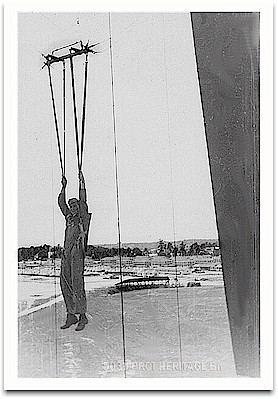|
-2-
The 503rd was a veteran outfit which had been in the Southwest Pacific since
late in 1943. They had made two combat jumps previously--one at Nadzab in Papua
New Guinea and another at Noemfoor in Dutch New Guinea. Most of the men knew,
very well, the role Corregidor had played in the early days of World War II
after Pearl Harbor. They knew, too, about the defenders of Bataan who had been
pushed back to the tip of the peninsula and forced to surrender by overwhelming
forces. To the bitter end on May 6, 1942 Corregidor had held out against many
weeks of bombing and shelling by the Japanese who needed Manila harbor open to
their shipping. Now it was the Americans who needed Manila harbor to service the
forces closing in on the "Pearl of the Orient", the city of Manila. A few days
before Navy ships attempting to clear mines in the main channel between
Corregidor and Bataan had been fired upon and had
several ships sunk while others were
badly damaged.*
Every trooper was bursting with pride that the 503rd had been chosen for this
historic mission. There was only one other Airborne unit in the whole Southwest
Pacific Area. The 11th Airborne Division had arrived in the area much later than
the 503rd and had missed much of the jungle training and fighting. When the 11th
was chosen to participate in the liberation of the City of Manila, the 503rd was
greatly disappointed. General MacArthur, however, assured us he had something
even better in store for us. When he informed Colonel George M. Jones, the 503rd
Commanding Officer, his Regimental Combat Team was to liberate Corregidor the
news was received with great enthusiasm.
While the number of Japanese infesting Corregidor was unknown, it was
optimistically suspected they would be planning for an amphibious landing as
they, themselves, had done in 1942. This was a big gamble because a few well
placed machine guns at Topside, as the area of the drop zones was known, and the
parachute landing could have been a disaster of a gigantic order. It turned out
that Japanese Navy Captain Akira Itagaki had surveyed the Island, after
he had received a warning from his superiors of the possibility of such a
landing. His study of the terrain convinced him it there was no area suitable
for an airborne landing. Consequently, he concentrated his efforts on setting up
defenses against amphibious invaders.
Japanese defenders were the potential peril uppermost in the jumpers minds. This
was the unknown factor. But there were other serious hazards of which they were
more certain. The miniscule size of the two drops zones has already been
mentioned.
Wind is a constant threat to parachute jumpers because is one of the factors
which cannot be known ahead of time with any degree of certainty. Information
about wind velocity and direction was sketchy but it was known the normal
direction for that time of year was from the Northeast to Southwest. The
velocity, however, could vary from a slight breeze to a zephyr of thirty miles
an hour. In non-combat training jumps it was the practice to curtail drops when
the wind exceeded fifteen miles an hour. Jumping in any higher winds always
brought unnecessary injuries.
|








